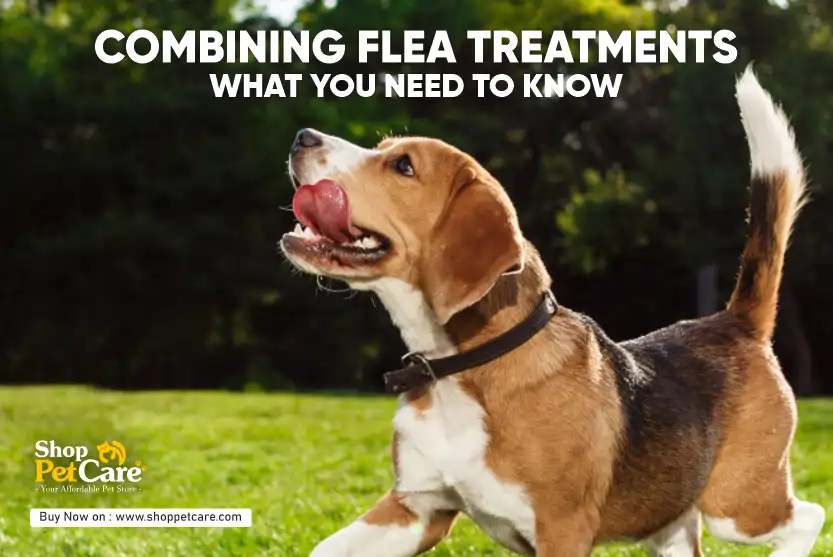Combining Flea Treatments for Dogs? – Safe Practices, Popular FAQs’ & Tips
Dog Owners! You need to go beyond fleas and ticks to make sure your dog is protected all around. Heartworms and gastrointestinal worms (roundworms, hookworms, and whipworms) are other parasites that are hard to see and are quite dangerous.
But not all medicines for parasites can guard against all of them, and the ones that can are not cheap for everyone. In these situations, a lot of dog owners combine two different medicines to make sure their dog is fully protected. This blog talks about the basics of combining flea treatments and some combinations that pet owners like.
Let’s get going!
How to Combine Flea Treatments: The Basics
The final goal is to make sure that everyone is safe from parasites. To give you an example, you can mix flea treatments that kill surface parasites with treatments that kill internal parasites.
If the active ingredients in both treatments are safe to use together, then the mixture is thought to work. Keeping this rule of thumb in mind, you can put together different sets to protect your dog completely. But it’s very important to talk to your vet before giving your pet any mix.
Understanding How Flea Treatments for Dogs Work:
1. What are the different types of flea treatments available?
There are different kinds of flea medicines, such as shampoos, oral, and topical.
2. How do topical flea treatments work to eliminate fleas?
When you put topical flea treatments on your pet’s skin, they work. The medicine gets into the pet’s system, and when a flea bites it, it eats the medicine and dies.
3. How do oral flea treatments work to eliminate fleas?
Oral flea treatments work because the pet eats them. The medicine then gets into the pet’s system. When a flea bites the pet, it eats the medicine and dies.
4. How do flea shampoos work to eliminate fleas?
Flea shampoos work by being put on the skin and clothing of the pet directly. There are chemicals in the shampoo that kill fleas right away and can also help soothe itching or soreness from flea bites.
Flea Treatment Combination: Safe or Risky?
1. Can I Treat My Dog for Fleas Simultaneously?
If your dog has a serious infestation or needs protection from various parasites, a vet may recommend repeated flea treatments. However, never combine treatments without medical advice. A vet can determine if the combo is safe and effective for your dog.
2. Can Flea Treatments Be Mixed Safely?
Only mix flea treatments if your vet tells you to. Overdosing may occur if items have identical active substances. This can lead to skin irritation, vomiting, allergic reactions, and more serious health complications. Read product labels, follow manufacturer instructions, and use only one flea medicine unless your vet recommends a combination.
Possible Dosage Combinations for Dogs
We’ll talk about some of the most popular Combination ways to treat pets in this part:
Combining Collars and Spot-on’s:
Flea collars like Seresto release active substances that kill and keep fleas and ticks away when they touch them. They work for a long time, up to 8 months. When used with topical treatments like Frontline Plus, which kills fleas, flea eggs, larvae, ticks, and chewing lice, the coverage can be improved because it kills parasites at different stages of their life cycle. This mix is good for dogs that are in dangerous places, but you should only use it with your vet’s permission to avoid overlapping ingredients.
Combining Collars and Oral Treatments:
A Seresto Flea & Tick Collar and an oral chewable like NexGard Chewables work together to protect both the outside and the inside of your pet. The collar repels and kills fleas and ticks on touch, while NexGard acts from within, killing fleas and ticks when they bite. This dual action can be quite helpful for dogs that are around a lot of fleas and ticks since it gives them extra protection against diseases that parasites might spread. You need to talk to your vet to make sure the mix is safe for your dog.
Combining Oral Treatments and Spot-ons:
Topicals like Frontline Plus kill fleas, ticks, and lice by getting into the skin, whereas oral medicines like NexGard kill parasites after they bite. You can use both to get rid of fleas and ticks at separate times: on the outside before they bite and on the inside if they do. This can help with bad infestations or in places where parasites are likely to become resistant. Always check with your vet before mixing.
Combining Fleas & ticks + Heartworm:
NexGard Spectra is an all-in-one product that protects against heartworm disease, fleas, ticks, and certain intestinal worms with just one monthly chew. This means you don’t have to mix different flea and tick preventives with heartworm drugs, which lowers the chance of missing a dosage or having an interaction. It’s a good option for keeping parasites away from a wide range of animals, but you should talk to your vet before using it to be sure it matches your dog’s needs.
Combinations to Avoid
Certain flea and tick medications, such as Frontline Plus with Advantage II or Advantage Multi with Revolution, should never be used together (unless combined with Capstar or a Preventic collar).
If your pet just had a flea or tick treatment, don’t give them a flea shampoo for a few days. The same goes for the other way around. Always give treatments time to work. While treating your home for fleas and ticks does not interfere with your pet’s preventatives, never spray the pet directly during home treatments.
Do not mix two products that kill the same parasites without first getting your vet’s OK. This could lead to overdose or other problems. Follow the dosage and regimen that your vet gives you, and don’t use any combination without talking to your vet first. It’s normal to want to act quickly, but giving your dog time to heal and following expert guidance will make sure that parasite control is safe and works.
Popular FAQ’s for Combining Flea Treatments for Dogs:
1. Can You Combine Oral and Topical Flea Treatment?
Yes, in some cases you can combine an oral treatment (like NexGard or Bravecto) with a topical treatment (like Frontline Plus) for broader parasite control. Oral treatments kill fleas and ticks after they bite, while topicals can kill or repel parasites on contact. This dual approach can be useful in severe infestations or high-risk environments. However, you should only combine them under veterinary guidance to avoid ingredient overlap or side effects.
2. Can You Use Capstar with Frontline?
Yes, Capstar (a fast-acting flea tablet) can be used with Frontline Plus. Capstar starts killing adult fleas within 30 minutes, while Frontline provides month-long protection against fleas, ticks, and lice. This combination is often recommended when you need immediate relief plus ongoing prevention. Always follow the dosing instructions for both products.
3. Can You Use a Flea Collar with Frontline?
In many cases, yes — a flea collar like Seresto can be combined with Frontline Plus for enhanced protection. The collar offers continuous flea and tick prevention for months, while Frontline targets fleas, ticks, and lice with monthly applications. Always check with your vet first to ensure the combination is safe for your dog’s age, weight, and health.
4. Can You Use Flea Medicine and a Flea Collar at the Same Time?
Yes, combining a flea collar with another flea preventive can provide layered protection. For example, Seresto Collar with an oral chew like NexGard or a topical like Frontline Plus can protect against multiple parasite threats. Vet approval is essential to prevent overdosing or ingredient duplication.
5. Can You Use a Flea Collar and Flea Drops at the Same Time?
Yes, flea collars like Seresto can sometimes be used with flea drops such as Frontline Plus. This may be beneficial in areas with high parasite pressure, as the products work in different ways. However, only do this under vet guidance to ensure ingredient compatibility and safety.
6. Can You Use Simparica and Frontline Together?
It’s possible, but generally not necessary to use Simparica (oral flea/tick chew) and Frontline Plus together. Both target fleas and ticks effectively, and combining them could increase the risk of side effects without added benefit. If your vet recommends this combination for a specific reason, follow their exact instructions.
7. Can I Use Capstar and Frontline Together?
Yes, you can. Capstar works quickly to kill existing adult fleas, and Frontline Plus provides long-term protection against fleas, ticks, and lice. Many vets recommend giving Capstar first for immediate relief, then applying Frontline the same day or shortly after for ongoing defense.
8. Can I Use Bravecto and Frontline Together?
It’s not usually recommended to use Bravecto (oral flea/tick treatment lasting up to 12 weeks) with Frontline Plus, as both cover similar parasites. Combining them may only be advised in rare cases, such as heavy infestations, and always under strict veterinary supervision.
9. Can I Use Capstar and Bravecto Together?
Yes, Capstar can be safely combined with Bravecto. Capstar kills adult fleas fast, while Bravecto provides long-term flea and tick prevention. This pairing can be useful when you need immediate knockdown along with extended protection.
10. Frontline and Heartgard Together?
Yes, Frontline Plus (flea, tick, lice control) can be safely used with Heartgard (heartworm preventive). They target different parasites and have different active ingredients, making them compatible for most dogs. Many pet owners use them together as part of a complete parasite prevention plan.
Final Thoughts
This is the end of our guide on how to mix flea treatments. We hope you now understand how to make these kinds of mixtures. You can make a preventative plan that fits your pet’s needs by carefully choosing treatments that work well together. But don’t forget to talk to your vet before giving your pet any kind of treatment, whether it’s by itself or with other treatments. Happy pet parenting!





